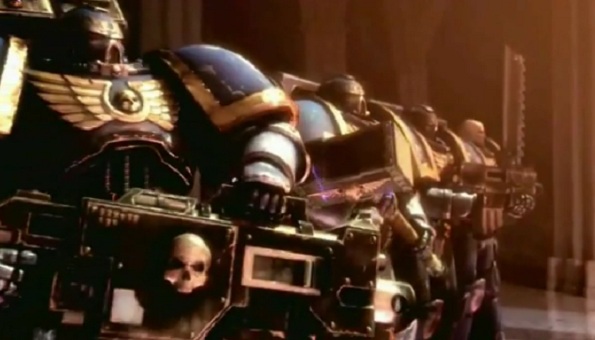Yesterday was my first day as a player in a newly started Warhammer 40.000 Deathwatch campaign. We got about halfway through the introductory adventure which was good fun, and pitted us against a few hordes of Xenos hostiles already. One thing I did find amusing, comparing it to the FASA Star Trek game I'm currently gm'ing, is that, if you were to merge the two settings and compare their relative ability, these guys
would get their asses handed to them by these guys:
Tuesday 31 January 2012
Friday 27 January 2012
Monsters & fun with names
Sometimes you spend ages trying to come up with appropriate/cool names for your monsters, NPCs, locations. Other times you just play around with words like you did when you were a little kid: anagrams, portmanteaus, backwards spelling (think D&D classics like Zagyg and Tenser). As my mind pondered the subject (don't ask), one thing led to another, and thus I present to you following monsters for your funhouse LL (or even MF) dungeon:
Holmvay Molds
No. Enc.: 1 (1)
Alignment: Neutral
Movement: 90' (30')
Armor Class: 7
Hit Dice: As original - 1
Attacks: 1
Damage: As original
Save: F2
Morale: 12
Hoard Class: None
XP: As original / 2
Created centuries ago by the demented alchemist Holmvay the Apothecary, the Mold disease is an airborne fungal spore which, through inhalation, nestles itself in the respiratory system of the host. The Mold quickly develops extensive colonies in the soft, moist tissue and then becomes passive, causing no discernible harm to the affected creature. Lying dormant in this state for up to many years, the spore only renews its activity upon the (natural) death of its host. Approximately one day after the host has died, white-greenish tendrils of mold start to form on the body of the deceased, starting around the mouth and nose. In 1D4 days the body is fully covered by the Mold, and even more exotic growths may occur (1D4: bioluminescent fungi - bubbling skin - black rot - corpse-pale flowers). At this stage the most spectacular fase of the Mold infestation starts, as the spore taps into the defunct nervous system and in this fashion reanimates the corpse. The creature subsequently becomes a Mold: a witless, shambling, unliving imitation of its former self. The Mold retains roughly the same physical strength and constitution as its deceased host, but loses all intelligence, inate abilities and can attack only once per round.
Upon death, there is a 50% chance the Mold will burst asunder in a cloud of spores. For anyone within 10' of the creature when this happens, and if no precautions have been taken (ie damp cloth over mouth and nose, magical means, etc), the LL makes a save vs death. On failure, the character unwittingly contracts the Mold disease, which can be removed by cure disease. If the character were to die and no resurrection is undertaken before the Mold sets in, the LL can apply penalties or other consequences to a tardy resurrection attempt.
On a different note: if Star Trek's Spock and Scotty were merged due to a transporter mishap, like in the Voyager episode 'Tuvix', would they have to call the result Spotty?
Holmvay Molds
No. Enc.: 1 (1)
Alignment: Neutral
Movement: 90' (30')
Armor Class: 7
Hit Dice: As original - 1
Attacks: 1
Damage: As original
Save: F2
Morale: 12
Hoard Class: None
XP: As original / 2
Created centuries ago by the demented alchemist Holmvay the Apothecary, the Mold disease is an airborne fungal spore which, through inhalation, nestles itself in the respiratory system of the host. The Mold quickly develops extensive colonies in the soft, moist tissue and then becomes passive, causing no discernible harm to the affected creature. Lying dormant in this state for up to many years, the spore only renews its activity upon the (natural) death of its host. Approximately one day after the host has died, white-greenish tendrils of mold start to form on the body of the deceased, starting around the mouth and nose. In 1D4 days the body is fully covered by the Mold, and even more exotic growths may occur (1D4: bioluminescent fungi - bubbling skin - black rot - corpse-pale flowers). At this stage the most spectacular fase of the Mold infestation starts, as the spore taps into the defunct nervous system and in this fashion reanimates the corpse. The creature subsequently becomes a Mold: a witless, shambling, unliving imitation of its former self. The Mold retains roughly the same physical strength and constitution as its deceased host, but loses all intelligence, inate abilities and can attack only once per round.
Upon death, there is a 50% chance the Mold will burst asunder in a cloud of spores. For anyone within 10' of the creature when this happens, and if no precautions have been taken (ie damp cloth over mouth and nose, magical means, etc), the LL makes a save vs death. On failure, the character unwittingly contracts the Mold disease, which can be removed by cure disease. If the character were to die and no resurrection is undertaken before the Mold sets in, the LL can apply penalties or other consequences to a tardy resurrection attempt.
On a different note: if Star Trek's Spock and Scotty were merged due to a transporter mishap, like in the Voyager episode 'Tuvix', would they have to call the result Spotty?
New blog
To keep the clutter of the Fallout blog I made this new blog where I'll be posting the (various & unrelated) products of my imagination, as I seem to have too much time on my hands to think of roleplaying stuff! Hurrah for office jobs I suppose. Perhaps I'll even attempt to offer an insightful comment or two, but I promise I'll keep those attempts to a strict minimum.
Subscribe to:
Posts (Atom)


